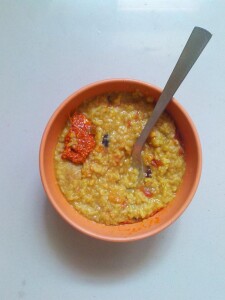 I’m not here to talk down the merits of mac ‘n’ cheese, which seems to have become America’s default comfort food. But I want to tell you about the merits – nay, the glories – of another food just as comforting and probably a bit better for you in the long run: khichdi.
I’m not here to talk down the merits of mac ‘n’ cheese, which seems to have become America’s default comfort food. But I want to tell you about the merits – nay, the glories – of another food just as comforting and probably a bit better for you in the long run: khichdi.
Khichdi is a South Asian dish that at its simplest is rice and lentils cooked together into a type of porridge. In fact it’s rather like the East Asian comfort food congee with the addition of pulses, in that it’s a blank slate for whatever flavors you want to color it with. And whatever degree of spiciness! The basic version, which in some parts of the Subcontinent is considered a baby’s first solid food, it’s just the rice and lentils served with some melted ghee stirred in.
The recipe I work from is simple: equal parts long grain white rice and lentils – either red masoor dal or yellow toor dal, also called pigeon peas. For four servings, use a half cup of each. Rinse them in a fine strainer until it drains clear, then add to a pot with 5-6 cups boiling liquid – water or any combination of water and stock or vegetable broth, with a teaspoon or so of turmeric, and maybe some peppercorns, a bay leaf, and some salt. (Yes, with pulses like peas and lentils you can add salt right at the beginning, unlike with beans, those legumes with tougher skins.) Bring that to a boil and then cook at a high simmer for 20 minutes or so.
While that’s cooking, prepare the topping that’s added at the last minute. It’s called variously tadka or chonk. Basically it’s spices fried in ghee. My favorite all-purpose tadka comes from Neela Paniez’s The Bombay Cafe (10 Speed Press, 1998). Start with a tablespoon or more of hot ghee in a small skillet; add 1 teaspoon cumin seeds, 1/2 teaspoon mustard seeds, 10 or 12 kari leaves (kaffir lime, not “curry” leaves); after the seeds quit popping, add a bunch of minced garlic and some serrano chiles sliced lengthwise. After a minute or so, pour in the pulp and liquid of a couple of good-sized tomatoes that you’ve grated. Just slice them in half and grate them down to the skin. Or you can dice them and then mash them with your wooden spoon as it’s cooking. Cook this at medium-high until the liquid has nearly all evaporated, 10 minutes or so. Your kitchen will smell glorious by now. (I like to pull the kari leaves out when it’s about done, and do the same with the bay leaf in the other pot.)
When the khichdi is of the consistency you want, which should be fairly thick, pour the tomato mixture into it, give it a quick couple of stirs and serve.
You can add vegetables, particularly greens, to the khichdi. It’s really good with a 5 or 6 ounce package of fresh spinach stirred in a few minutes before it’s all done. One of these days I’ll try it with some more bitter greens, perhaps some broccoli rabe or tatsoi.
Like I said, the tadka can be simpler: straight ghee, or ghee with some cumin seeds, a couple of dried chiles, maybe a pinch of asafetida and a shake of whatever pure chili powder you have on hand. Sweet or hot smoked paprika would be good. Or you can brown some onions in the ghee with your spices – cumin seeds, some chopped ginger, coriander, cayenne, fresh chiles and chopped tomatoes.
So have fun and experiment. (I’m hoping to try it with brown rice instead of white – this will probably require some soaking and maybe use of more robust lentils like regular brown or green ones.) And see if khichdi doesn’t become one of your staples for breakfast, lunch or dinner.
